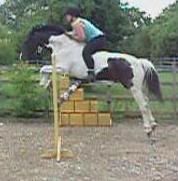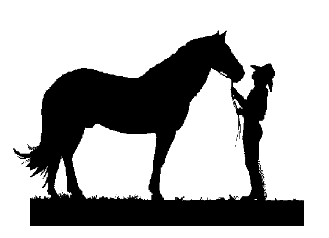ceej
Administrator  im back.... :)
im back.... :)
Posts: 5,363
|
Post by ceej on Jul 25, 2008 10:35:21 GMT
Brigs and Maxi you will like this!
Now when I was taught to ride (basically by my mum who was taught by a pupil of Spanish riding school - but alas we had no school so all on hacks) I was taught to your leg (and i dont mean a supporting leg, but you know, put your leg on) to increase the pace OR because horse (when training) needs riding forward (eg working trot to collected, or just into the bridle) but to help legs get under.
However, I was taught NOT to keep pushing on to maintain the correct gait when there. Hense I have always had horses who you tell to go and tell to stop - you dont need to tell them to keep going - save when you are collecting eg collected trot else they would slow to walk. Am I making sense?
Now recently, I have had so many people telling me to keep my leg on - keep pushing him on etc etc (despite the fact Harrys way of going is quite nice - he isnt a slouch!). I started to think I was the only one who had not beentaught this way (these are mainly BHS trained people - not necessarily a training method I always agree with) but anyhoo...then I read in YH today a dressage lesson where the instructor says:
'At the moment its impossible for you to change the tempo because you are already kicking every stride just to maintain the gait (what people keep telling me to do) YOu shoudl be able to put him into gear - be it walk, trot, or canter - and he should stay there until you tell him to change his pace (how I have been taught) If you are using your leg and nothing is changing, its just a waste of your energy'
Such a method also means you end up requiring even more leg to change pace and thats how, imo lots of horses become 'dead' to the leg and you end up needing a stick to get them moving on more - this coudl be why riing school methods are increasing this behaviour - taught to keep kicking every blinking stride coz the horseswodl grind to a halt otherwise.
Does anyone have any comments on this? As I say, I dont mean this as a blanket rule as you sometimes ned to drive your horse into the bridle and up and under you so to speak - soemtimes thatsto improve the gait you are in or can be a change in gait - eg from working to collected. Have many people misunderstood this to mean kicking to maintain the current pace or is there really two methods here?
|
|
haffyfan
Administrator  is pressing random buttons...sorry guys
is pressing random buttons...sorry guys
Posts: 7,391
|
Post by haffyfan on Jul 25, 2008 10:52:28 GMT
Ideally imo the horse should continue at the pace you have asked for until you ask it otherwise (Murph very often has other ideas on this!). This is how all western horses are trained leaving the rider free to rope cattle etc.
It's a long time since I had formal 'english' training, as I ahve used more western styled techniques/elements with my two, but a lot more leg is necessary for collection etc as the horse is not encouraged to work in self carriage in the same way a western trained horse is, but I don't agree with 'constant nagging' which it sounds like is being suggested you do.
|
|
|
|
Post by fleabitten on Jul 25, 2008 10:54:34 GMT
no, at my riding school, you are taught to ask with your voice then a nudge or squeeze (depending on whether its lazy or forward naturally), then a kick (if nothing happens) and then a tap with the whip (if still nothing happens). And then once you have gotten into your desired pace you just use your legs if he slows down. And my RI is BHS qualified.
Although i have seen riders kicking non stop - and one place the child on a pony was trotting round and Ri wasnt even paying attention to it and it was all over the place, she only looked up and told it to shorten its reins when it got to the back of the ride...
|
|
ceej
Administrator  im back.... :)
im back.... :)
Posts: 5,363
|
Post by ceej on Jul 25, 2008 11:04:42 GMT
I have been watching a few people whilst out hacking recently and all of them have kept nudging the sides every couple of strides, even though the horse is not slowing down.
Maybe I have misunderstood what people have said though - it just seems to have become a habit with a lot of people?
The instructor goes on to say this for a lazy horse, and its so tru -its so easy to keep pushing them on to maintain the pace rather than letting them make the mistake and correcting them - i think this is a trap many (incluing me on RS horses) make:-
'I only want you to use your legs when you really need to. What you find, especially with a lazy horse, is they'll get you to keep the leg on and carry them round. But the longer you lave your leg on, the less sensitive the horse becomes. If he wants to stop, let him. Once he has stopped you can let him know its not acceptable.
As if on cue, Tonto's pace starts to slow "keep your leg off. You ahve to let him make the mistake so he can learn from it" Tonto stops (just because she has stopped with her leg - not other aides to stop!!) Now kick and send him forwards - and again, until he trots on...Tonto leaps forward into a trot and maintains it.
he improved loads after that, but she needs to be reminded quite often to keep her leg off!! He lateral works improves no end because he starts listening to the leg too....
|
|
|
|
Post by Becca on Jul 25, 2008 11:32:21 GMT
ceej that last bit sounded almost like transitions exercises (but with natural stopping), which is good i find for making horses more responsive.
I find you have a much more enjoyable ride if your aren't nagging the horse as haffy said. It is a habit you pick up at riding schools i think because many of the horses are bored. so then the RI's get into the habit of telling rider to keep the horse going. saying that i know full well i was a culprit of this and only learnt when i rode non school horses that you didn't need to kick every stride
|
|
|
|
Post by kateflashy on Jul 25, 2008 11:50:01 GMT
i was always taught to just rest your legs against the side of your horse and just put on pressure to in crease the tempo, gait etc , or to squeze them into a square halt , not that i ever do , as all mine are live wires and just breathing differently means go evven faster to them lol
|
|
|
|
Post by brigadier on Jul 25, 2008 15:39:56 GMT
You are right Ceej- i just love this sort of debate. Ive ridden to both schools of thought and infinitily prefer the tell the horse then leave it alone with a passive cuddling leg that only asks when needed. Unfortunately when the horse starts going slower we then get tempted to keep nudging it forward and then the leg nagging becomes a habit- (and its great youve just posted this because Ive realised that Im back into the habit)
One of the problems I find is with fizzy horses that some people cant ride because of a hot bum!- This type of horse, rather perversley, responds better to a strong supporting leg rather than an aid then no contact, and will become kinder and more passive the stronger the leg becomes- the difficulty is getting it on in the first place! Strangely enough the stronger then you become with your leg the lighter you can become with the hand as the horse is contained within the leg and seat, and as the horse is fizzy and forward going theres no problem with pace.
I think this may be where the confusion over leg leg leg has come in, theres a difference between a supporting leg and an asking leg, but when taught at novice level, the rider will only understand leg means nudge or kick. A good example of this is in the shoulder in exercise where the rider must put the inside leg on to maintain the bend and it needs to be an active inside leg to ensure the horse follows the three tracks, but it doesnt nudge, it is supportive and generates movement- but how to explain that to a novice- if you say use your inside leg- they can only interperate that one way- as a nudge/kick.
Also once an outline is correctly achieved through the activity of the hocks contained within the seat and legs, the hand again can become light and guiding- but this again takes leg- but the right kind of leg, not nudging or kicking but cuddling and supporting and if done correctly the horse never becomes idle to it- rather the opposite and responds to the lightest touch of insdie leg.
I could go on for hours about this ceej- Im not saying Im correct as its something that is of great debate especially now there's a greater respect for alternative riding. We can only do what works and adapt when it stops working. sometimes though the BHS are their own worst enemies and they promote methods that are too rigid in such a diverse pastime- unfortunately we are stuck with them for the time being as they seem to dominate initial training methods.
Its not for nothing though that a lot of the top riders go abroad for their tuition.
Its a good post this and has got my cogs going!
|
|
ceej
Administrator  im back.... :)
im back.... :)
Posts: 5,363
|
Post by ceej on Jul 25, 2008 16:04:21 GMT
argh god you once again managed to say exactly what I was TRYING to say in my post!!
in my usual rambling fashion!
|
|
arumanii
Apprentice Poo Picker
 
Posts: 360
|
Post by arumanii on Jul 25, 2008 22:25:32 GMT
lol -through sheer laziness I'm with ur school of thought on this debate -I really just could not do with having to constantly nag a horse to keep them going, my legs would fall off (Yes, I am sure that this would happen)  |
|
|
|
Post by maximum on Jul 26, 2008 18:37:50 GMT
Totally agree with Brig and I AM guilty of it as Max is a bit lazy but basically once you have asked the horse to move off the leg into whatever pace it may be then it should maintain that until such time as you ask it to stop.
I see so any people flapping away - especially in canter- and tell them to stop! the leg gets the horse forward and once in canter it should continue until asked to do something else wether that is a change of pace or a change within the pace. Yes by all means if the horse loses impulsion and needs ridden forward then a reminder is required but there is no advantage in the chinese water torture school of thought re the nagging leg.
I love the Carl hester demos where he is basically saying when he has a hot horse like Escapado he rides it with the leg round it all the time as it will dash off if he takes the leg off and back on again so he keeps it queitly on the horses side and uses when needed
but with a lazy horse he gets the leg on sharpish, then off - totally off ( I find a hinged knee joint helps!) and if it slows down then leg on/off until it gets the idea!
he does expalin it better than I do!!and there are youtube clips but I cant find that paricular one right now.
|
|
|
|
Post by brigadier on Jul 26, 2008 20:32:53 GMT
Ive watched and really enjoyed the demos Ive seen that Hester has done- he talks a lot of sense and has a natural empathy with horses! Would like to go to a live demo- missed one recently.
|
|
suzii
Novice Willy Washer
   Officially In Love With A Young Bay Man :D
Officially In Love With A Young Bay Man :D
Posts: 882
|
Post by suzii on Jul 27, 2008 13:03:04 GMT
I had the problem that my horse wasn't listening to my leg and I was constantly nagging. My instructer said to let him grind to a halt and then kick him on sharply and tell him to get moving. Because then he knows the leg means go on.
She said if I am changing gait or want to speed up then if he doesn't listen to my leg use my whip.
This worked and in about 2 lessons he was much more responsive.
|
|
|
|
Post by brigadier on Jul 27, 2008 20:48:26 GMT
good advice!
|
|


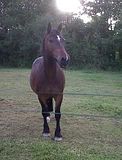
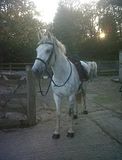

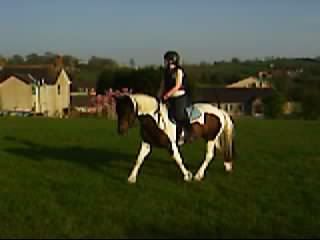

 )
)
 Always saddle your own horse
Always saddle your own horse

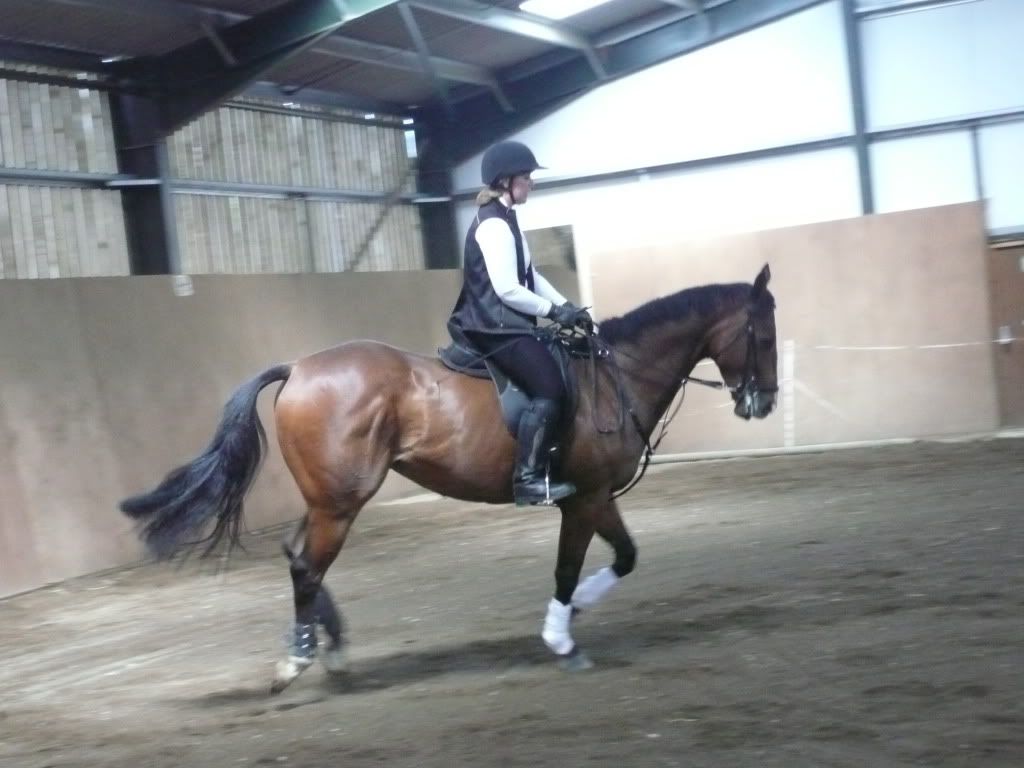
 for so much hard work we thank ye!!
for so much hard work we thank ye!!